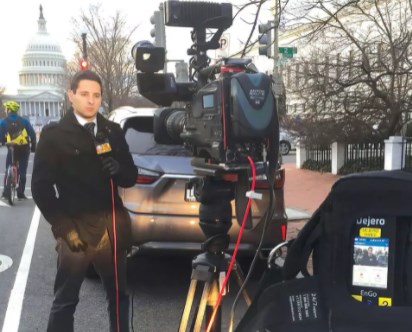English 

ADD: Building B, Langling Industry Park, Dongsheng Road, Huaxing Industry Area, Xinhua Town, Huadu District, Guangzhou, Guangdong, P.R.China, Zip:510800

Views: 99 Author: web Publish Time: 2021-07-27 Origin: web

Shooting for electronic newsgathering (ENG) is usually done on a tight schedule and requires mobility with equipment. The crew shows up to a location and usually has to be in and out quickly and efficiently. They could be moving to and from multiple locations each day and shooting many different places within one larger area.

This is separate from shooting in the studio. It is the practice of going out and gathering pieces for news stories, which can include more run-and-gun scenarios like capturing events, but also more sophisticated sit-down interviews on location. Lighting-wise, it is best to have a package that is mobile and versatile.
LIGHTWEIGHT AND TRANSPORTABLE
Most manufacturers that cater to ENG shooters try to make their lights as lightweight as possible. There are smaller fresnels and panels that are easily moveable and transportable. They also package them in cases that store more than one light, so you can carry multiples in one flight case or bag.
RECOMMENDED VIDEOS FOR YOU...
Companies such as Ikan, ARRI, Lite-panels and Nila have great kits that provide tools and accessories to change the quality, intensity, color and shape for what you need. A typical kit will come with two or three units and include barn doors, gel inserts and sometimes even soft boxes. Panels are great soft lights with inserts of diffusion that are interchangeable so the quality of the light can be affected easily without a lot of grip-page having to be built around the light. Usually ENG is conducted by one or two crew members, so building stands and large rags is usually not an option.
An important thing to keep in mind is having units that are bicolor. There are so many options now, and the LED units that can change between tungsten and daylight do a decent job of color accuracy. It is quicker than having to use a gel. Being able to dial specific Kelvin temperatures can allow the artificial lighting to blend with lighting in the environment that may be a little cooler than tungsten, but not quite true daylight and vice versa.
This helps eliminate the amount of units you need, if the ones you have naturally provide different color options. You don’t need to haul different kits for color with you to a job. LEDs not only provide the flexibility in color, but being LEDs you have battery-powered units and don’t have to rely on a location’s power situation. If you do need to run power from the location, LEDs provide a worry-free solution as they draw much less power than traditional tungsten lights. You won’t have to necessarily go check the breaker box when you are out shooting with limited time.
Utilizing the available light in a space is key to shooting ENG, but much of the time it’s not the most flattering light. A lot of public buildings have a lot of cove lights in the ceilings, which create a hard top light that isn’t consistent. When a subject walks around, they go in and out of these lights. Sometimes they won’t match in color because a bulb or two have been replaced.
ON-CAMERA LIGHTS
One of the things that constantly comes up in shooting ENG is the need to provide an eyelight, especially when faced with ugly top light in interiors. If you don’t have time to light an interview with units on stands and design the frame, you need a fast, easy light to serve as an eyelight. A good example is when interviewing someone inside for an event such as a conference. Having a small on-camera light is about as minimalistic as you can get and being bicolor will help it blend with the location lighting, unless of course you want it to feel like an on-camera light.
News reporter lit naturally with a single light on camera to supplement (Image credit: Photo Credit: Marc Erlick)
If the light is just to supplement what’s there and not draw attention to itself, having something that can be softened and match the ambient lighting color is best. One of my favorite small, mobile lights that could be used on camera is the Aputure M9. It’s dimmable and has both diffusion and color panels you can slide on easily.
Just as an AC on a film set has a run bag, an ENG shooter should as well. Aside from the light kit and camera case, a run bag can provide another opportunity to bring these smaller on-camera lights and accessories to help combat poor lighting situations. You can pack all your batteries, a few compact lighting options, light accessories, tools and more.
ENG shooting has become much simpler and painless with the latest in lighting technology. It’s now completely mobile and allows for more artistic tools that are compact, letting ENG shooters bring more equipment for endless creative possibilities.
Julia Swain is a cinematographer based in California, whose narrative films include “Killing Animals,” “Jilted” and “Cassidy Red.” She continues to shoot on a variety of formats, seeking to create compelling visuals for every story and brand. She can be contacted through TV Technology.


Guangzhou Weijia Photoelectric Tech., Co., Ltd has been established since 2009. The factory is Located in Guangzhou of China, very near the Baiyun International Airport. We have more than 3000sqm workshop, around 30 workers.
Guangzhou Weijia Photoelectric Tech., Co., Ltd is a fast growing stage lighting manufacturer, which combines the R&D, manufacturing, sales and technical service. The high quality products are guaranteed by the self-developed mechanical design and program, advanced R&D lab, Electronics workshop, Assembling workshop and Q/A department and the cooperation with the high-quality material suppliers.
